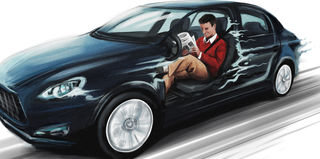Environment
Will Your Next Car Drive Itself?
The conflict between technology and consumer experience.
Posted April 18, 2017

Each year the leading technology companies exhibit their latest consumer gadgets at the CES trade show, an event produced by the Consumer Technology Association.
This year the technology innovations on display were dazzling: autonomous (self-driving) cars; connected devices that can communicate with each other—while the consumer talks to them through natural language-recognition technology; a refrigerator that keeps track of what’s inside on its shelves; a trash can that reads product codes on discarded packages and then creates shopping lists for restocking; brushes that analyze hair; forks that analyze food…and hundreds more.
While these new technologies are designed to solve problems or fulfill desires; the key to their success is the degree to which they create experiences that engage and satisfy consumers.
Experiences, and especially their emotional components, are the foundations of our lives. Our minds create neural representations of the world we encounter. These neural images are the substance of consumer experiences. Mental images populate our past; define the present, and by manipulating them through thought we use them to create our future. It is neural representations, rather than some absolute external reality, that determine whether we will buy and use a new technology.
The way to understand innovation is to consider it from the perspective of the experience of the consumer, not the apparent breakthrough capability or uniqueness of the technology. For example, Thomas Edison thought he had invented a machine that would be used to dictate messages in an office. However, his technology only found great success when it was adapted to play recorded music, creating the consumer experience of the record player, which at that time revolutionized entertainment.
Today, one of the most talked about new technologies is the self-driving car. It seems inevitable that autonomous cars will have a place in our future. The question is whether they will occupy a small, specialized segment or be the dominant form of personal transportation. The answer lies in the experience that autonomous cars deliver to consumers.
The automotive industry promotes autonomous cars on the basis of the increased safety that results from removing human drivers, whose errors are the largest cause of accidents. Additional consumer benefits include replacing the drudgery of the commute to work with an opportunity to relax, maybe to catch up on reading; and making errands more enjoyable with time to play with the kids while riding to the mall, for example.
But for autonomous cars to be a market success, their benefits must be perceived as more important and desirable than the experience that consumers have when getting behind the wheel. This could be difficult because research reveals that consumers love to drive. Their experience includes haptic feedback—strong, positive emotional responses to touch and feel which result from hands on the steering wheel, controlling the car with pedals, and, for some, shifting a manual transmission.
Other experiences of driving include emotions of freedom and power, feeling liberated, sometimes in the context of getting away from the constraints of everyday life. On the more extreme end of experience, writer P.J. O’Rourke describes driving in terms of emotions resulting from driving fast—“the feelings we get when we’re falling in love—obsession, bliss, complete emotional and physical engagement.”
The pleasure of the driving experience is demonstrated in Tom Voelk’s “Driven” video car reviews. These features appear regularly on the New York Times website and have become very popular. While Voelk exhibits vast knowledge of car technology, his genius is an ability to identify and describe the experience behind the wheel of every type and size of car. He distills those differences into sound bites that drivers understand and appreciate.
Another difference between driving and riding in an autonomous car is the experience of being connected to the environment we are traveling through:
- When we walk, we experience the visual and sensual surroundings, as well as the people along the way.
- When driving we control what our senses perceive by focusing on surroundings as we direct the car. We can get rich mental images by rolling down the window or pausing to take in an interesting street scene.
- The experience of riding in an autonomous car might be more like being on a bus. Yes, streets, buildings, and people are visible outside the windows. But in the bus we become disconnected. We see the environment passively through perceptions of the bus. We experience the bus, not the environment.
We live in an age of breathtaking developments in technology. When new technologies are applied to consumer products, they capture our attention. However, innovative technologies themselves don’t produce consumer acceptance. A refrigerator that gives recipes won’t make cooking more fun. A fork that analyzes food won’t make meals more enjoyable. Product success depends the consumer experience that technologies create. Maybe self-driving cars will achieve that, but they have a steep hill to climb.
copyright 2017 Peter Noel Murray, Ph.D




